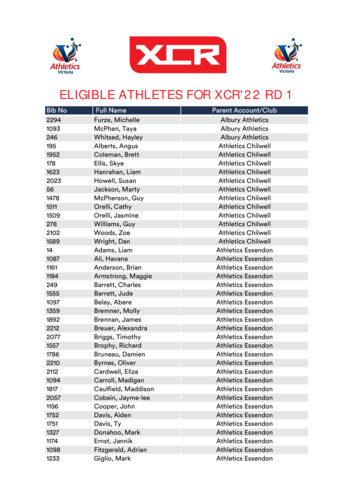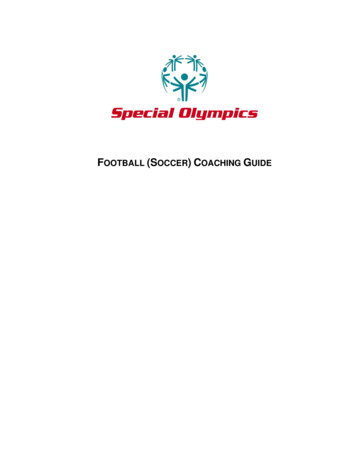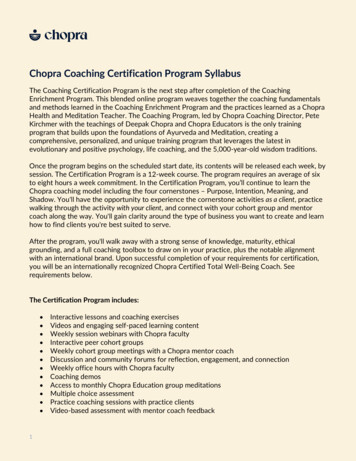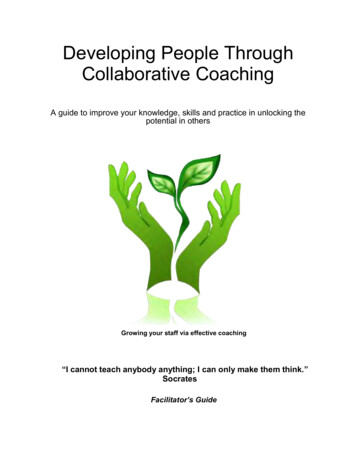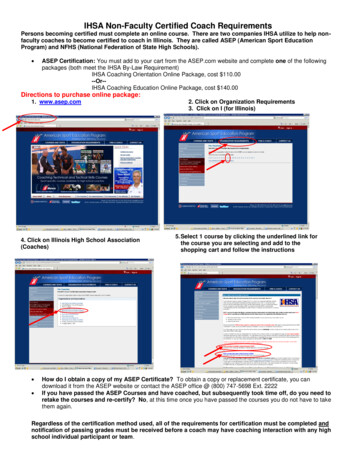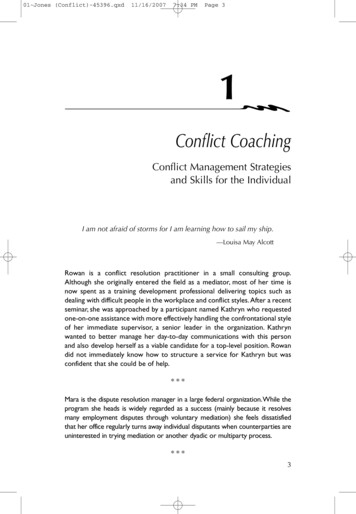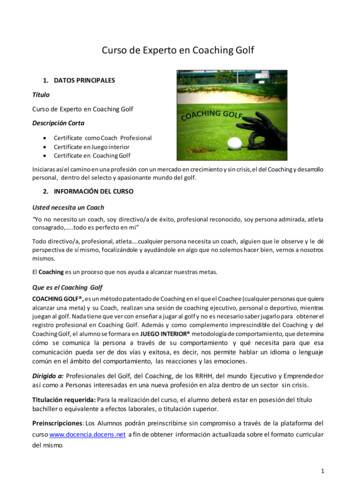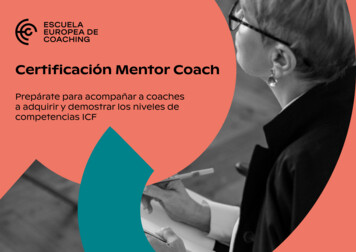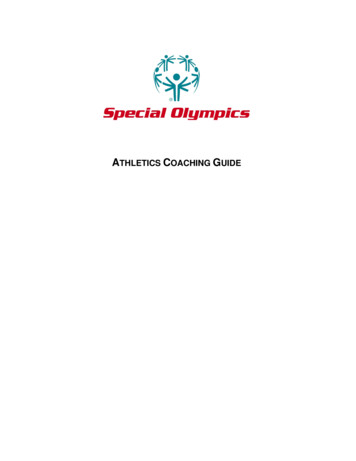
Transcription
ATHLETICS COACHING GUIDE
Special Olympics Athletics Coaching GuideThe Benefits of AthleticsThe Benefits of AthleticsThe sport of athletics encourages athletes of all abilities and ages to compete at their optimum level. Through the trackand-field-based athletics training program, participants can develop total fitness to compete in any sport. As with allSpecial Olympics sports, athletics offers athletes the opportunity to learn through skill development and competitivesettings and to be involved in large social settings.In essence, success in athletics depends on the athlete's determination and practice habits. Yet merely byparticipating in an athletics training program, the athlete can learn:self-disciplinethe ability to make independent decisionslifelong fitness skills that will help him or her lead a more productive and independent life.There are many different skill levels demonstrated by Special Olympics athletes, and the coach has theresponsibility of learning the skill level of each athlete. Using that knowledge, the coach takes the resources provided inthis guide and adapts the information as it applies to each athlete. Levels from basic to advanced are accommodated inthe guide, giving the coach a range of skills and drills to choose from. All information is a guideline, to be used by thecoach in a way that works for his or her athletes. If a skill or drill looks too difficult, the coach can simply modify it asrequired to help the athletes learn and perform. Keep in mind that to help athletes improve and grow, it is good for thecoach to challenge them by continually observing and assessing their skills, providing new techniques and drills andgiving positive encouragement, regardless of their skill level.2Special Olympics Athletics Coaching Guide- September 2007
Special Olympics Athletics Coaching GuideAcknowledgementsAcknowledgementsSpecial Olympics wishes to thank the professionals, volunteers, coaches and athletes who helped in the production ofthe athletics Coaching Guide. They have helped fulfill the mission of Special Olympics: to provide year-round sportstraining and athletic competition in a variety of Olympic-type sports for people 8 years of age and older withintellectual disabilities (mental retardation), giving them continuing opportunities to develop physical fitness,demonstrate courage, experience joy and participate in a sharing of gifts, skills and friendship with their families, otherSpecial Olympics athletes and the community.Special Olympics athletics welcomes your ideas and comments for future revisions of this guide. We apologize if,for any reason, an acknowledgement has been inadvertently omitted.Contributing AuthorsSuzie Bennett-Yeo, Special Olympics AustraliaVenisha Bowler, Special Olympics, Inc.Wanda S. Durden, Special Olympics, Inc.Dave Lenox, Special Olympics, Inc.Ryan Murphy, Special Olympics, Inc.Karla Sirianni, Special Olympics, Inc.Kelly Zackodnik, Special Olympics CanadaSpecial Thanks To the Following for All of Your Help and SupportJanusz Rozum, Special Olympics PolandTony Wayne, Special Olympics North CarolinaPaul Whichard, Special Olympics, Inc.Special Olympics CanadaBrenda Hill, CoachVideo Featuring Athletes from Special Olympics CanadaFern BremaultChris DotyGino LucarelliSarah McCarthyBlayne UsselmanSpecial Olympics VirginiaVideo Featuring Athletes from Special Olympics VirginiaSpecial Olympics Athletics Coaching Guide- September 20073
ATHLETICS COACHING GUIDEPlanning an Athletics Training and Competition Season
Planning an Athletics Training and Competition SeasonTable of ContentsTable of ContentsGoalsAssessing Goals ChecklistPeriodizationConfirmation of Practice ScheduleEssential Components of Planning a Athletics Training SessionPrinciples of Effective Training SessionsTips for Conducting Successful Training SessionsTips for Conducting Safe Training SessionsAthletics Practice CompetitionsSelecting Team MembersCreating Meaningful Involvement in Unified Sports Athletics Athlete Skills AssessmentSpecial Olympics Athletics Skills Assessment CardDaily Performance RecordAthletics AttireAthletics EquipmentGeneral Athletics Equipment List At-A-GlanceSpecial Olympics Athletics Coaching Guide- September 20075
Planning an Athletics Training & Competition SeasonGoals and ObjectivesGoalsRealistic, yet challenging goals for each athlete are important to the motivation of the athlete both at training and duringcompetition. Goals establish and drive the action of both training and competition plans. Sport confidence in athleteshelps to make participation fun and is critical to the athlete's motivation. Please see the Principles of Coaching sectionfor additional information and exercises on goal setting.BenefitsIncreases athlete's level of physical fitness.Teaches self disciplineTeaches the athlete sports skills that are essential to a variety of other activitiesProvides the athlete with a means for self-expression and social interactionGoal SettingSetting goals is a joint effort with the athlete and coach. The main features of goal setting include the following.1.2.3.4.5.Structured into short-term, intermediate and long-termStepping stones to successMust be accepted by the athleteVary in difficulty - easy attainable to challengingMust be measurableLong Term GoalThe athlete will acquire basic athletics skills, appropriate social behavior and functional knowledge of the rulesnecessary to participate successfully in athletics competitions.6Special Olympics Athletics Coaching Guide- September 2007
Planning an Athletics Training & Competition SeasonGoals and ObjectivesAssessing Goals Checklist1. Write a goal statement.2. Does the goal sufficiently meet the athlete s needs?3. Is the goal is positively stated? If not, rewrite it.4. Is the goal is under the athlete s control and that it focuses on their goals and no one else s?5. Is the goal a goal and not a result?6. Is the goal important to the athlete that they will want to work towards achieving it? Have the time and energy todo it?7. How will this goal make the athlete s life differently?8. What barriers might the athlete encounter in working toward this goal?9. What more does the athlete know?10. What does the athlete need to learn how to do?11. What risks does the athlete need to take?Special Olympics Athletics Coaching Guide- September 20077
Planning an Athletics Training & Competition SeasonSeason PlanningPeriodizationOrganization and planning are the keys to a successful Athletics program. Planning for the season ahead is actuallyaccomplished backwards. The coach and athlete work back in time beginning with preparation and early competitionsuntil arriving at the beginning of the training year. All training plans are best when flexible and simple. This will allowfor modifications resulting from an athlete s progress and improvements. The major objective of any training andcompetition program is to ensure the athlete is fully prepared mentally and physically to perform at their greatestcapacity. The term periodization is used to describe the division of a training and competition programme. Each periodhas specific training objectives. The following periods of training work best when followed regardless if the timeavailable is one full year, six months, twelve or eight weeks.1. Preparation Periodo Pre Season Training2. Competition Period3. Transition PeriodPreparation PeriodThe first and longest period of any training and competition program is the preparation period. In this period, athletesmove from general to specific training. The main objective is to prepare athletes for competition. Fitness andconditioning is developed in this period by gradually increasing the volume of training. This will allow the athlete toaccomplish the demands of specific training. Note that volume does not increase in a straight line. It is implemented insteps to allow time for recovery and overcompensation.Specific preparation follows general preparation work. During this training phase, both volume and intensity areincreased. For the runner, mileage will reach its highest level. Training becomes more event specific with conditioningfocusing on the energy systems used in the event. Remember that technique work is accomplished when the athlete isnot fatigued, therefore, comes before general fitness training.8Special Olympics Athletics Coaching Guide- September 2007
Planning an Athletics Training & Competition SeasonSeason PlanningCoach Pre Season Planning and Preparations1. Improve your Athletics knowledge and skills by attending training schools and clinics.2. With your Sport Administrator, locate a facility with the proper equipment for practice sessions (e.g., highschool, recreation center, university, etc.).3. Recruit volunteer assistant coaches from high school or college athletics programs.4. Establish goals and draw up a minimum eight-week training and competition plan. Schedule a 2-5 five practiceseach week for the minimum eight weeks period.5. Please note that some of the Distance events require a longer training and competition plan in order to properlytrain and prevent athlete injury.6. Schedule "mini" meets against other local teams.7. Ensure that all prospective athletes have thorough physical examinations before the first practice. Also, be sureto obtain parental and medical releases.Preseason TrainingAthletes are encouraged to develop and maintain year round, good physical fitness and nutritional habits. Suggestionsfor ongoing fitness programming are included in the general coaching section, Athlete Nutrition, and Fitness. Athletesthat arrive for training in a state of general good health and fitness are more likely to yield better competitionperformances and year round results.Preseason Training Goals1. Development of sports-specific muscle strength and endurance2. Development of appropriate aerobic (endurance) and anaerobic (high intensity) conditioning3. Development of muscle power4. Development of sports-specific skillsLong JumperDistance RunnerAerobic vs. AnaerobicAnaerobicAnaerobicMuscle StrengthLegs, trunk, shouldersMuscle EnduranceMuscle PowerLegs and thighsOverall conditioningFlexibility and AgilityHips, ankles, shouldersHipsNote that both the long jumper and distance runner are working with the anaerobic system during the preseason, asthey both need to build a fitness base, increase their endurance. However, the distance runner will log many more milsthan the long jumper.As with year round fitness and conditioning training, preseason training is be characterized by the followingprinciples.SpecificityProgressive increase in load, time, frequencyOverload to encourage gradual adaptationResistance Recovery - RestTotal commitment to taskSpecial Olympics Athletics Coaching Guide- September 20079
Planning an Athletics Training & Competition SeasonSeason PlanningAlthough the decision regarding how often to practice is dependent on many variables including coachingavailability, facility availability, life commitments, it is advisable to practice 3-5 times weekly during the preseasonperiod. More days of practice are suggested as the weeks available in the pre-season period decrease.Remember the pre-season period is a time of skill development and work, but to keep all your players successfullyinvolved, it must always be FUN!!Examples of Pre Season ProgrammingThe examples of preseason activities are presented to suggest ideas as you plan for your athletes. The coach shouldassess the athletic activity to determine the proportion of aerobic vs. anaerobic conditioning is necessary to participatesuccessfully.Aerobic ConditioningAnaerobic ConditioningRunningSprintingSwimmingHill TrainingCyclingFartleksThe coach will need to assess the athletic activity to determine which muscles need specific strength and/or power tocompete most successfully. See Section 7 for more information on training theory.Strength is the ability of a muscle or muscle group to exert force. Examples of specific strength include thesprinter s need for strength in the thigh and calf muscles, or the shot putter s requirement for strength in the shoulderand trunk.Power is the ability of a muscle or muscle group to exert force quickly. Examples of power might include therunner s need for explosive power in the thigh muscles, or the shot putter s requirement for explosive power to drive upand out with the shot.Competition PeriodDuring the competition period, volume is gradually deceased and intensity increased. For instance, heavier weights arelifted, but less often. Speed workouts are run faster, however recovery times are longer. Competition characteristics aresimulated during this training period. Mini competitions, local area or dual area competitions are a good trainingcompetitions during this period. It is important to keep training loads heavy enough to improve athlete s fitness levels,yet light enough to boost enthusiasm and maintain high energy levels. An athlete s athletic shape is at its highestduring this period.In Season TrainingPlan each practice session according to what needs to be accomplished, using the athletes' individual progress andgradual event specification as guidelines for planning. Continue to use the skills assessments to record each athlete sprogress from the general preparation phase t specific preparation accompanied with mini competitions.The training program during the actual season has two primary goals: maintenance of the gains of pre-seasontraining; and continued specific attention to areas of the body at risk either from past injury, or the particular risks of thesport.10Special Olympics Athletics Coaching Guide- September 2007
Planning an Athletics Training & Competition SeasonSeason PlanningTransition PeriodThis period is also called the active rest period. The end of the season is drawing near and we do not want the athleteto lose all that they have gained. The main objective of the transition period is to allow athletes to recover mentally,physically ad emotionally from their hard work during the preparation and competition periods. Implement low volume,low intensity cross training exercises during this. Do anything other than the event that your athletes have been trainingfor in the previous periods. Have some fun.Rest should be increased to allow rejuvenation. The athlete should be encouraged to engage in an alternate activitythat is enjoyable, less strenuous, and relaxingAn ExampleGeneral Training for the JumpersPost Season Planning1. Review preseason goals and determine how many of them were achieved.2. Ask for comments from the athletes and family members.3. Write an evaluation of each athlete, and of the season, to send to family members.4. Instruct the athletes to participate in other sports training and competition programs, and to continue using theirwarm up, stretching, strengthening, and cool down exercises to stay fit during the off-season.Special Olympics Athletics Coaching Guide- September 200711
Planning an Athletics Training & Competition SeasonSeason PlanningConfirmation of Practice ScheduleOnce your venue has been determined and assessed you are now ready to confirm your training and competitionschedules. It is important to publish training and competition schedules to submit to the interested groups below. Thiscan help generate community awareness for your Special Olympics Athletics Program.Facility RepresentativesLocal Special Olympics ProgramVolunteer CoachesAthletesFamiliesMediaManagement Team membersOfficialsThe Training and Competition schedule is not exclusive to the areas listed below.DatesStart and End TimesRegistration and/or Meeting areasContact phone number at the facilityCoaches phone numbers12Special Olympics Athletics Coaching Guide- September 2007
Planning an Athletics Training & Competition SeasonPlanning a Training SessionEssential Components of Planning a Athletics Training SessionSpecial Olympics athletes respond well to a simple well-structured training outline with which they can becomefamiliar. An organized plan, prepared before you get to the athletics center, will help establish such a routine and helpmake best use of your limited time. Every practice session needs to contain the following elements. The amount of timespent on each element will vary because of several factors.Warm upsPreviously taught skillsNew SkillsCompetition experienceFeedback on performance.The final step in planning a training session is designing what the athlete is actually going to do. Remember whencreating a training session using the key components of a training session, the progression through the session allowsfor a gradual build up of physical activity.Easy to difficultSlow to fastKnown to unknownGeneral to specificStart to finishSpecial Olympics Athletics Coaching Guide- September 200713
Planning an Athletics Training & Competition SeasonPlanning a Training SessionPrinciples of Effective Training SessionsKeep all activeAthlete needs to be an active listenerCreate clear, concise goalsLearning improves when athletes know what is expected of themGive clear, concise instructionsDemonstrate increase accuracy of instructionRecord progressYou and your athletes chart progress togetherGive positive feedbackEmphasize and reward things the athlete is doing wellProvide varietyVary exercisesEncourage enjoymentTraining and competition is fun, help keep it this way for you and yourathletesCreate progressionsLearning in increased when information progresses from:prevent boredomKnown to unknown discovering new things successfullySimple to complex seeing that I can do itGeneral to specific14this is why I am working so hardPlan maximum use of resourcesUse what you have and improvise for equipment that you do not havethink creativelyAllow for individual differencesDifferent athletes, different learning rates, different capacities.Special Olympics Athletics Coaching Guide- September 2007
Planning an Athletics Training & Competition SeasonPlanning a Training SessionTips for Conducting Successful Training SessionsAssign assistant coaches their roles and responsibilities in accordance to your training plan.When possible, have all equipment and stations prepared before the athletes arrive.Introduce and acknowledge coaches and athletes.Review intended program with everyone. Keep athletes informed of changes in schedule or activities.Alter the plan according to weather, the facility in order to accommodate the needs of the athletes.Change activities before the athlete become bored, and lose interest.Keep drills and activities brief so athletes do not get bored. Keep everyone busy with an exercise even it is rest.Devote the end of the practice to a fun, group activity that can incorporate challenge and fun always giving themsomething to look forward to at the end of practice.If an activity is going well, it is often useful to stop the activity while interest is high.Summarize the session and announce arrangements for next session.Keep the fun in fundamentals.Special Olympics Athletics Coaching Guide- September 200715
Planning an Athletics Training & Competition SeasonPlanning a Training SessionTips for Conducting Safe Training SessionsThough the risks can be few, coaches have a responsibility to ensure that athletes know, understand and appreciate therisks of athletics.Establish clear rules for behavior at your first practice and enforce them.1. Keep your hands to yourself.2. Listen to the coach.3. When you hear the whistle, Stop, Look, and Listen4. Ask the coach before you leave the field of playWhen the weather is poor, have a plan to immediately remove athletes from inclement weather.Always rope off the throwing areas so that athletes do not wander into the line of throwing.Never play around with the shot puts or relay batonsMake sure athletes bring water to every practice, especially in hotter climates.Check your first aid kit; restock supplies as necessary.Identify the nearest phone accessible during practice.Ensure that the locker rooms and or rest rooms are available and clean during practice.Train all athletes and coaches on emergency procedures.Do not allow athletes to play while wearing watches, bracelets, or jewelry including earrings.Provide proper stretching exercises after warming up at the beginning of each practice.Provide activities that also improve general fitness levels. Fit athletes are less likely to get injured.16Special Olympics Athletics Coaching Guide- September 2007
Planning an Athletics Training & Competition SeasonAthletics Practice CompetitionsAthletics Practice CompetitionsThe more we compete, the better we get. Part of the strategic plan for Special Olympics Athletics is to drive more sportdevelopment at the local levels. Competition motivates athletes, coaches and the entire sport management team. Expandor add to your schedule as many competition opportunities as possible. We have provided a few suggestions below.1.2.3.4.5.6.Host mini meets with adjacent local Programs.Ask the local high school can your athletes compete with them as a practice meet.Join the local community running clubs and/or associations.Host weekly all comer s meets for the area.Create a running league or club in your community.Incorporate competition components at the end of every training session.Special Olympics Athletics Coaching Guide- September 200717
Planning an Athletics Training & Competition SeasonSelecting Team MembersSelecting Team MembersThe key to the successful development of a Traditional Special Olympics or Unified Sports team is the properselection of team members. We have provided some primary considerations below for you.Ability GroupingUnified teams work best when all team members have similar sports skills. Partners with abilities that are far superior toother teammates will either control competition or accommodate others by not competing to their potential. In bothsituations, the goals of interaction and teamwork are diminished and a true competitive experience is not achieved. Forexample, in Football, an 8 year old should not be competing against or with a 30 year old athlete.Age GroupingAll team members should be closely matched in age.Within 3-5 years of age for athletes 21 years of age and underWithin 10-15 years for athletes 22 years of age and overCreating Meaningful Involvement in Unified Sports Unified Sports embraces the philosophy and principles of Special Olympics. When selecting your Unified team youwant to achieve meaningful involvement at the beginning, during and end of your sport season. Unified teams areorganized to provide meaningful involvement for all athletes and partners. Every teammate should play a role and havethe opportunity to contribute to the team. Meaningful involvement also refers to the quality of interaction andcompetition within a Unified Sports team. Achieving meaningful involvement by all teammates on the team ensures apositive and rewarding experience for everyone.Indicators of Meaningful InvolvementTeammates compete without causing undue risk of injury to themselves or others.Teammates compete according to the rules of competition.Teammates have the ability and opportunity to contribute to the performance of the team.Teammates understand how to blend their skills with those of other athletes, resulting in improvedperformance by athletes with lesser ability.Meaningful Involvement Is Not Achieved When Team MembersHave superior sports skills in comparison to their fellow team members.Act as on field coaches, rather than teammates.Control most aspects of the competition during critical periods of the game.Do not train or practice regularly, and only show up on the day of competition.Lower their level of ability dramatically, so that they do not hurt others or control the entire game.18Special Olympics Athletics Coaching Guide- September 2007
Planning an Athletics Training & Competition SeasonAthletics Skills AssessmentAthletics Athlete Skills AssessmentThe sport skills assessment chart is a systematic method useful to determine the skill ability of an athlete. The AthleticsSkills Assessment Card is designed to assist coaches in determining athlete s ability level in athletics before they beginparticipation. Coaches will find this assessment a useful tool for several reasons.1.2.3.4.5.Help coach to determine with the athlete which events in which they will competeEstablish the baseline training areas of athleteAssist coaches to group athletes of similar ability in training teamsMeasure the athlete s progressionHelp determine athletes daily training scheduleBefore administering the assessment coaches need to perform the following analysis when observing the athlete.Become familiar with each of the tasks listed under the major skillsHave an accurate visual picture of each taskHave observed a skilled performer executing the skill.When administering the assessment coaches will have a better opportunity in getting the best analysis from theirathletes. Always begin by explaining the skill you would like to observe. When possible demonstrate the skill.Special Olympics Athletics Coaching Guide- September 200719
Planning an Athletics Training & Competition SeasonAthletics Skills AssessmentSpecial Olympics Athletics Skills Assessment CardAthlete s NameDateCoach s NameDateInstructions1. Use tool at the beginning of the training/competition season to establish a basis of the athlete s starting skilllevel.2. Have the athlete perform the skill several times.3. If the athlete performs the skill correctly 3 out of 5 times, check the box next to the skill to indicate that the skillhas been accomplished.4. Program Assessment Sessions into your program.5. Athletes may accomplish skills in any order. Athletes have accomplished this list when all possible items havebeen achieved.Running BasicsMaintains a balanced and upright postureCan maintain a hips tall positionLifts opposite knee/arm while runningDoes not swing the arms in front of the body or rotate the shoulders while runningStartsPerforms a stand up sprint startDemonstrates proper sprinting formTakes relaxed "On Your Mark" position in the starting blocksTakes balanced "Set" position in the starting blocksPerforms a sprint start out of the starting position upon hearing start commandAthlete performs a stand up startSprintsAthlete can perform a stand up or block startAthlete has good foot speedDemonstrates ability to start and finish a sprint eventAthletes sprints under controlAthlete likes to run fast20Special Olympics Athletics Coaching Guide- September 2007
Planning an Athletics Training & Competition SeasonAthletics Skills AssessmentHurdlesAthlete attempts to step over a low barrierAthlete demonstrates the ability to step over a low obstacle while runningAthlete demonstrates flexibility in hipsAthlete demonstrates ability to start and finish a sprintAthlete likes running over barriersRelaysReceives baton in a visual passPerforms an upsweep/palm down baton passPerforms an downsweep/palm up baton passPerforms baton pass in exchange zoneRuns designated leg of relay race in proper mannerAthlete runs to teammate in proper laneAthlete runs in lane while reaching back with designated armAthlete can run to teammate with batonAthlete runs in lane while looking back at incoming runnerAthlete can run 100MAthlete can run 400MAthlete likes running relays with teammatesMiddle DistanceAthlete can run for 3 minutes at a steady paceAthlete can run for 30 seconds at a fast paceAthlete likes running 2-4 laps around trackLong Distance RunningRuns in balanced and erect postureDemonstrates correct distance running formDemonstrates ability to start and finish a 1600M raceDemonstrates ability to run at a certain paceSpecial Olympics Athletics Coaching Guide- September 200721
Planning an Athletics Training & Competition SeasonAthletics Skills AssessmentRunning Long JumpPerforms a 9-step approachPerforms a single leg takeoffDemonstrates the step-style flight techniqueDemonstrates the hang-style flight techniqueDemonstrates proper landing techniqueJumps on command and under controlAthlete can perform a good standing long jumpAthlete can locate his/her starting markAthlete can locate takeoff boardAthlete likes jumping into sand pitStanding Long JumpAssumes a ready-to-jump positionDemonstrates the correct takeoff for a standing long jumpDemonstrates proper flight techniqueDemonstrates proper landing techniqueJumps on command and under controlAthlete can perform two-leg takeoffAthlete likes jumpingHigh JumpPerforms a 7-step approach for a flop style high jumpPerforms a flop style jump, landing on backPerforms a scissor style high jumpPerforms a 7-step approach for a scissor-style high jumpJumps on command and under controlAthlete can jump up into the air off one footAthlete can take off with one foot and land in the pitAthlete can perform a consistent three-step approachAthlete can perform a one-foot takeoffAthlete can jump backward into the pitAthlete can run on a curveAthlete likes jumping22Special Olympics Athletics Coaching Guide- September 2007
Planning an Athletics Training & Competition SeasonAthletics Skills AssessmentShot Put (for wheelchair athletes too)Grips shot correctlyTakes a ready-to-put positionPerforms a standing put, or wheelchair sitting putPerforms a sliding putPerforms a glide putPuts shot in a forward directionPuts shot in the shot put marking areaPerforms reverse or weight transferAthlete can balance the shot in the palm of one handAthlete can safely pick up and hold the shot in the proper positionAthlete likes putting the shotRace WalkingRace walks in a balanced and erect postureRace walks in proper form at low speedsRace walks at various speeds, slow-fastRace walks in competitive formRace walks under controlAthlete likes race walkingWheelchair RacingAssumes a ready-to-race positionPerforms a forward stroke and recoveryDemonstrates ability to com
3. Recruit volunteer assistant coaches from high school or college athletics programs. 4. Establish goals and draw up a minimum eight-week training and competition plan. Schedule a 2-5 five practices each week for the minimum eight weeks period. 5.
